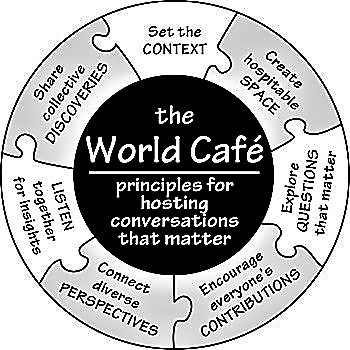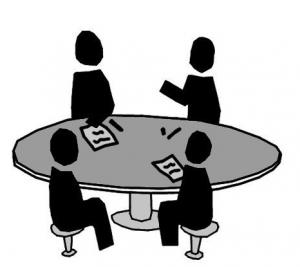Executive Summary
Finding consensus can be particularly difficult when a bigger group is involved. World Café is a group discussion technique applicable to group sizes from ten to several hundred participants, enabling cooperative dialogues and therefore facilitating social learning and consensus finding (THE CHANGE INITIATIVE n.y.). It is well suited for meetings, workshops, conferences, congresses, etc. Setting up a café-resembling atmosphere and splitting the group into sub-groups of four to seven participants promotes relaxed and open discussions. Reassembling the groups and summarising the outcomes in a final collation helps to further exchange knowledge and ideas.
Introduction
World Cafés are used for the discussion of clear questions, which matter for real life problems. The aim is to achieve collaborative dialogues by setting up open and creative conversations in a casual café atmosphere (THE WORLD CAFÉ 2008). By connecting people’s knowledge, new comprehension can be generated, leading to common ground and collective knowledge (see also group works). World Cafés therefore also help reducing conflicts.
Needed Material
(Adapted from SCHIEFFER et al. 2004)
Only little specific material is needed for implementing a World Café, making it cheap and easy to conduct. For setting up a café-style atmosphere, the following logistical preparation is required:
- Tables and chairs for a cluster style seating arrangement. The tables can either be round or small rectangles and should have seats for four to five participants.
- Paper and markers for each table (see also managing coloured cards)
Additionally, further decoration and background music can be applied to enhance the resemblance of an ordinary café.
How is it Conducted?
(Adapted from THE WORLD CAFÉ 2012)
For a basic implementation, the following five steps need to be considered:
1. Setting
Setting up an atmosphere resembling an ordinary café with cluster-style seating (tables with four to five chairs).
2. Welcome and Introduction
The host welcomes the group and introduces the participants to the process and the rules.
3. Small Group Rounds
Opening with the first of at least three discussion rounds in small groups. After twenty minutes, each member of a group changes to a different table, where a new conversation is started (see also time management).
4. Questions
Each new session is introduced by stating the question open for discussion as well as the purpose of the round. New questions can be applied to each round (e.g. by building on the previous question) but it is also possible to discuss the same issue throughout several rounds. The questions posed need to matter for real world situations and be clearly formulated (see also how to set system boundaries and to outline your area).
5. Whole Group Conversation (Synthesising)
After the group discussions, main ideas and results are shared within the whole group to harvest and synthesise the findings. The results can be visually supported for better understanding (e.g. by using flip charts or mindmapping).
Seven main principles further structure the process of a World Café, being:
- Setting the context (including the identification of stakeholders, the definition of the boundaries)
- Creating a hospitable space
- Exploring questions that matter
- Encouraging everyone’s contributions (see also facilitators role)
- Connecting diverse perspectives
- Listening together for insights
- Sharing collective discoveries

Special Roles
There are several special roles which need to be considered for a successful implementation of a World Café:
Café Convener
The person or group calling for the World Café. The role of the convener is not to promote the World Café, but rather to invite to participate in order to achieve a fruitful outcome.
Café Host
The café host helps to manage the World Café and provides enough structure in order to enable the process. He holds the role of a facilitator.
Table Host
During the iterative process of changing tables, the table host stays at the same table, welcoming new arrivals. During the discussions, the table host is an equal member of the conversation.
Member/Participant
General participants, travelling from table to table during the iterative group process.
Design Team
The design team is responsible for the overall design and implementation of the World Café, helping to assure its success.
World Café is a tool used for social learning and consensus finding. It is well suited for big groups (up to several hundred), as the discussions find place within sub-groups. Therefore, World Café is a technique often used for meetings, workshops and trainings, conferences, congresses, etc. As most cultures have a café-tradition, it can be used within all cultural contexts (THE CHANGE INITIATIVE n.y.). Conducting this technique is a cheap and easy method, as not much material is stringently necessary.
The World Café
World Café
The World Café. Catalyzing Large-Scale Collective Learning
How did the idea of the World Café develop? A summary of the World Café inventor, Juanita Brown, about the history and the main aspects of the technique.
BROWN, J. ; ISAACS, D. ; MARGULIES, N. ; WARHAFTIG, G. (1999): The World Café. Catalyzing Large-Scale Collective Learning . In: Leverage: News and Ideas for the Organizational Learner: Volume 33 , 1-2. URL [Accessed: 11.07.2012]The World Café. Living Knowledge through Conversations that Matter
An article describing the main ideas as well as the origin and history of the World Café technique.
BROWN, J. ; ISAACS, D. ; THE WORLD COMMUNITY (2001): The World Café. Living Knowledge through Conversations that Matter. In: The System Thinkers: Volume 12 , 1-5. URL [Accessed: 25.06.2012]World Cafe Guidelines & Principles
A youtube video describing the guidelines and principles of the World Café.
YOUTUBE (2009): World Cafe Guidelines & Principles. URL [Accessed: 11.07.2012]The World Cafe Community
Website, where World Café practitioners share their experience. It also provides a platform for holding World Café’s online.
The World Cafe
Website maintained by the World Café Community Foundation, containing diverse information about the method.
Knowledge Cafe
Contains an overview on the World Café technique (here called “Knowledge Café”). The website includes a list of links to articles, videos and other documents related to the topic.


